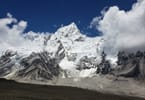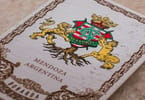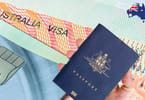Scattered around the shores of this tiny Polynesian island, many of the more than 900 male-shaped stone monoliths, called moai, can be found face-down rather than gazing calmly from an upright position as in the iconic image of the Easter Island statues.
“They were thrown down,” explains local tour guide Cristian Reyes, pointing at the backs of five toppled statues. “Something happened here that made these people destroy their own gods.”
Such tell-tale reminders attest to this island’s history of self-destruction, which some locals fear could repeat itself given the island’s current rate of tourism expansion.
Rapa Nui (popularly known as Easter Island), has watched tourism more than double in the past few years, thanks in large part to the attention generated by its nomination for the New 7 Wonders of the World contest, a popular global competition to choose the world’s most awe-inspiring sites.
Leading up to the final vote in July 2007, Easter Island had consistently been in the Top 10, but it didn’t make the final cut. While it was a disappointment to many islanders at the time, many now say losing is actually the best thing that could have happened to their fragile island.
“We have more than 50,000 visitors during the year, which means more than 11 times the total population of the island,” says Reyes, looking over the turquoise waters of Anakena beach, on Rapa Nui’s north shore.
A mere 4,000 people live on this 166-square-kilometre patch of hills and volcanoes. Despite being the most remote inhabited island on Earth, tourism has boomed, going from 22,000 tourists in 2003 to more than 50,000 in 2006. Since losing the New 7 Wonders contest, however, that number has remained stable, with 50,000 tourists in 2007. But still, Chile’s Ministry of Public Works expects the number of visitors to soar to as many as 200,000 a year by 2020; an airport expansion is slated to start in 2011.
Most tourists are drawn to the mystical moai, which are truly amazing to behold, and much more impressive than one can imagine from photos. What’s more: they’re everywhere. With some 900 moai, many as tall as 10 metres, buried or visible across the island, and a total of 26,000 archeological sites, Rapa Nui is a breathtaking open-air museum and UNESCO World Heritage Site.
Besides its statues, the island’s culture is alive and going through a revival. Young artists tattooed in traditional symbols sell beautifully carved wooden decorations. An impressive array of groups perform Polynesian dances. The island also offers pristine beaches, surfing and scuba diving.
It’s no wonder this unique island is so popular with tourists.
With increasingly affordable airfares from Chile and a number of cheap guest houses, even young backpackers are making the trek — a trend some islanders are keen to reverse.
“We would prefer a high-quality tourism,” says Reyes. “Maybe not more people, but people with more money asking for more professional services.”
Once a tourist here himself — this Chilean lawyer came to the island to scuba dive four years ago, fell in love, and decide to stay and start a family — he says the island needs to be more choosey about who can visit.
Edgard Hereveri, until recently the president of the Rapa Nui Chamber of Tourism, agrees, saying that too many local authorities are ignoring tourist impact studies. He estimates the island could handle up to 70,000 or 80,000 tourists — but only as a best-case scenario, with an integrated tourism management plan and environmental regulations.
Hereveri worries about a mountain of garbage that’s thrown into open pits or burned. He says there are also problems with sewage contamination and energy consumption. Demand for electricity has soared so high over the past two years that the island has had to implement brown-outs during its peak season in February, around the time of a popular annual festival called Tapati.
Fish species are also being depleted. Even lobsters, which were used to feed prisoners as recently as the 1970s, are running scarce.
“There were once seven different types of land birds here,” says Reyes. “Now they’re all gone — extinct. There were 26 different types of seabirds. Only 11 survive today — only 11! Something happened here.”
Rapa Nui’s history is an ominous parable cited in environmental textbooks. It tells of a culture that overextended itself and brought about its own ecological suicide.
The population declined drastically before the arrival of European explorers in 1722. Researchers say the Rapa Nui people chopped down all their trees to make wooden frames to hoist up their moai in a frenzied competition of one-upmanship among rival tribes. Desertification ensued and the Rapa Nui were unable to grow food. Without wood to make boats, they could no longer fish. Soon, starvation began and the island eventually descended into civil war and cannibalism.
Even the island’s revered moai were attacked. These imposing male-shaped statues represented the gods and were a symbol of power and authority for the nobility, says Reyes. Every single standing statue was knocked off its altar in an island-wide rebellion against the ruling classes. Even their coral eyes — which were said to give them life — were destroyed.
“Try to imagine how desperate they must have been to kill the gods, the royalty and all the social, political and economic systems they had established through centuries,” says Reyes.
The art of the time reflects their despair, says artisan Cesar Manutomotomo, as he carves a likeness of a kava kava spirit, a skinny man-like creature. “During the drought, the wars, the cannibalism, many people went hungry. They calculate that up to 20,000 people lived on this small island, so people became skinny, like this.”
When Europeans discovered Rapa Nui in the 18th century, fewer than 1,000 inhabitants were left, says Julio Hotus, who heads the islands’ department of culture and tourism.
“Our civilization may have managed to build massive statues, but at a great cost to its environment and its people. That’s why it’s so important to pay attention to the lessons of our forefathers.”
When tourism began on the island 20 years ago, Hotus says locals believed the more tourists they brought to the island, the more money they’d make. But by the 1990s, he says, that mentality started changing along with increasing problems with contamination, erosion and the deterioration of the archeological sites.
Today, islanders struggle to find a balance between curbing the harmful effects of too much tourism, and cutting off their main source of income.
Most sites still have no visible fencing or barriers. Tourists are free to roam the island on horseback, motorcycles or rented cars.
But this freedom comes with a price. Last year, Hotus witnessed the father of Chile’s minister of national property hit a moai with a stone in an attempt to demonstrate to his wife how they were carved. He was fined $6,000. In April, a young Finnish tourist was fined $20,000 for cutting the ear on one of the moai that adorn the landscape at the island’s best beach.
Organized tours for visitors make less of an impact, since guides are careful to tell visitors where they cannot step. Most have stopped visitors from clambering up onto the altars that surround the statues to get a better picture.
But the Rapa Nui themselves are also to blame, says Reyes, showing us a cave where he says locals sometimes sleep or have parties.
“They own the ruins — at least that’s what they think. And (they think) they can do whatever they want with the ruins. Right now, we are repeating at a global scale and a local scale the same misbehaviour that the Rapa Nui did to their own island. These people are now destroying the environment and their own ruins.”
Nature is also threatening the sites, says archeologist Sergio Rapu.
“The moai are (also) dying from natural causes,” he says. “The stone they were made of erodes quickly when the water penetrates and dissolves the organic material … The prehistoric Rapa Nui people noted that it would take 300 to 400 years approximately for those statues to become completely eroded, such that the features of the face would no longer be recognized.”
Rapu says that at least the New 7 Wonders contest raised awareness.
“When Rapa Nui became one of the candidates to be one of wonders of the world, it was also an (alarm) bell for the authorities to say wake up and look at what’s going on around. If we haven’t learned anything from the past — the good and the bad — then we’re blind.”
With these words in mind, it’s not hard to see irony in a scene at sunset: hundreds of looming moai stare inward watching the tiny island — but without their coral eyes to see.
Jen Ross is an Ottawa-born freelance writer now based in Chile. When her daughter was born nine months after Ross visited Easter Island last year, she named her Anakena after the island’s most beautiful beach.
IF YOU GO …
When to go: Some consider February the best month to visit because of the Tapati festival, which features traditional singing and dancing, a parade and woodcarving and tattooing competitions, but it’s also the busiest time and the hardest on the island’s limited resources. February is also the hottest month, with occasional bouts of dengue fever. June through August, on the other hand, are the coolest months, with temperatures in the 10- to 17-degree range. The best times to avoid both crowds and low or high temperatures are March through June and September through December.
How to get there: Air Canada and LAN Chile offer direct flights from Toronto to Santiago, Chile for about $1,000. From Santiago, the only way to get to the island is with LAN Chile; package deals are often the best way to go. LAN Tours offers packages that include flights, accommodations and tours, with a range of prices. December to March is high season and can cost twice as much as travel during other months.
Where to stay: There are few high-end options on the island; cabins are the best value.
– Vai Moana Cabins: These simple motel-style rooms are clean and well-kept, tucked amidst beautiful gardens with traditional statues. The hotel also serves a delicious fresh breakfast with local island produce. About $40 to $93 per night. See www.vai-moana.cl or call 011-56-32-210-0626.
– Hotel Hanga Roa: Overlooking the ocean, this hotel is in a great spot close to everything and within walking distance of several moai, restaurants and Pea Beach. It has a pool, WiFi and its own restaurant (Kona Kai). About $150 to $240 a night. www.hotelhangaroa.cl or 011-56-32-210-0299.
– O’Tai Hotel: Surrounded by beautiful gardens, Hotel O’Tai is a small hotel located in the heart of town. It is simple but comfortable with a Polynesian atmosphere. About $90 to $135 a night. http://hotelotai.com or 011-56-32-210-0250.
Where to eat: There are about two dozen restaurants on the island; the local specialty is fish and seafood. You can’t leave the island without trying fresh tuna, or a tuna empanada.
– Kanahau Restaurant: This cosy restaurant is decked in beautiful wood carvings and often offers live music. The food is excellent, though pricier than many of the other options on the island: about $60 for dinner for two.
– Te Moana: One of the most popular restaurants on the island, located on the main street (you need to get there early to get a table). A live band often plays on Wednesdays and the weekends; about $40 for dinner for two.
– Merahy Ra: Near the beach, this is a larger restaurant with many fish options and a more affordable menu; about $30 for dinner for two.
– Pea Restaurant: Right on the water. this restaurant offers live music and cultural videos along with meals and pubfare; about $40 for dinner for two.
Tours: Do as many as you can, as the island is a treasure trove of archeological gems.
– Aku Aku Turismo offers the best variety of tours with knowledgeable and funny guides. The full-day tour of the island takes you to the Ranu Raraku volcano, the Tongariki Ahu, Anakena Beach and several other sites. Scuba diving and snorkelling tours are also available in warmer months. www.akuakuturismo.cl or 011-56-32-210-0770.
– Kari Kari Cultural Ballet: See at least one traditional dancing show; Kari Kari is the best. http://karikari.bizland.com/english
More:
– Chile’s National Tourism Service: www.sernatur.cl/internacional
– Rapa Nui Chamber of Tourism: http://visitrapanui.bizland.com/eng
– Rapa Nui travel agency: www.rapanuiturismo.cl
WHAT TO TAKE AWAY FROM THIS ARTICLE:
- Rapa Nui (popularly known as Easter Island), has watched tourism more than double in the past few years, thanks in large part to the attention generated by its nomination for the New 7 Wonders of the World contest, a popular global competition to choose the world’s most awe-inspiring sites.
- With some 900 moai, many as tall as 10 metres, buried or visible across the island, and a total of 26,000 archeological sites, Rapa Nui is a breathtaking open-air museum and UNESCO World Heritage Site.
- While it was a disappointment to many islanders at the time, many now say losing is actually the best thing that could have happened to their fragile island.






















